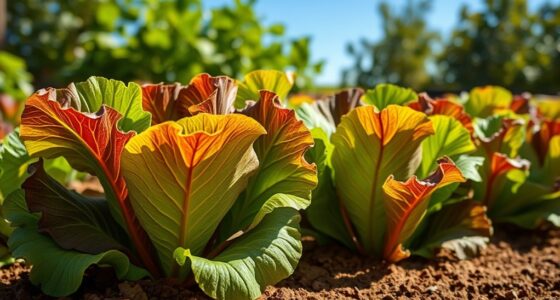To combat powdery mildew on squash vines, start by improving air circulation with proper spacing, pruning affected leaves, and removing debris promptly. Apply organic fungicides like neem oil or sulfur early, and monitor plants for early signs. Water at the base of plants and avoid overhead watering to keep foliage dry. Choosing resistant varieties and practicing good garden hygiene can also prevent outbreaks. Want detailed steps to protect your squash? Keep exploring how to keep fungi at bay.
Key Takeaways
- Improve airflow by proper spacing, staking, and pruning to reduce humidity and inhibit mold growth.
- Remove and destroy infected leaves and debris promptly to eliminate spore sources.
- Apply organic fungicides like sulfur or neem oil early, reapplying every 7-10 days as needed.
- Water at the base early in the day to keep foliage dry and avoid overhead watering.
- Incorporate resistant squash varieties and maintain garden hygiene for long-term disease prevention.
Recognizing the Signs and Symptoms of Powdery Mildew
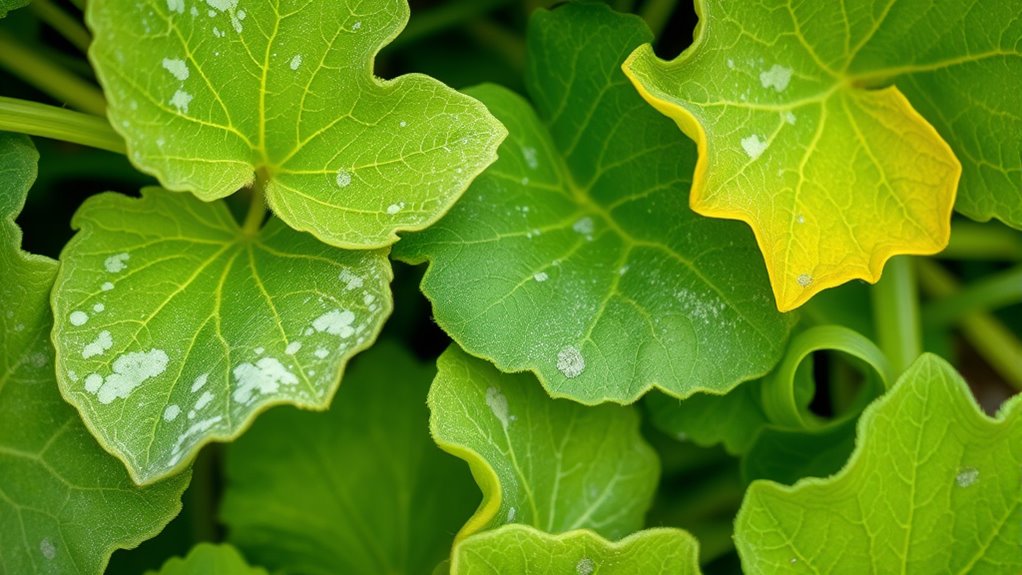
Powdery mildew often shows up on squash vines as a white or grayish powder that appears on the leaves, stems, and sometimes even the fruits. To identify it early, look for distinct patches of powdery residue that spread quickly across surfaces. Identification tips include checking for circular or irregularly shaped spots that start small and enlarge over time. As the infection progresses, the powdery coating thickens, causing leaves to become yellow, dry, and curl. You might notice a fuzzy texture on affected areas, and eventually, the plant’s growth can slow down. Recognizing these signs early helps you catch the disease before it spreads extensively. Monitoring symptom progression is key to implementing timely treatment and preventing further damage to your squash vines. Proper disease identification can help you determine the most effective treatment options and protect your crop. Regular inspections and understanding the signs of infection are crucial for early intervention and maintaining healthy plants. Being aware of environmental factors that favor powdery mildew development can also assist in preventing outbreaks. Additionally, understanding how humidity and airflow influence disease spread can aid in implementing preventative measures.
Understanding the Conditions That Favor Fungal Growth

You’ll notice that high humidity levels and poor air circulation create perfect conditions for fungal growth. When plants are overcrowded, airflow slows down, making it easier for powdery mildew to thrive. Managing these factors helps keep your squash vines healthier and less prone to infection. Additionally, maintaining proper garden hygiene can reduce the presence of fungal spores in the environment. Incorporating space management techniques can further improve airflow and decrease humidity around your plants. Optimizing plant spacing is essential for preventing fungal diseases and promoting overall plant health. Implementing ventilation strategies, such as pruning and staking, can also significantly reduce humidity and improve air movement around your squash vines. Being aware of regional climate conditions can help you anticipate and prevent outbreaks of powdery mildew.
Humidity Levels Rise
When humidity levels rise, the environment becomes highly favorable for fungal growth, including powdery mildew on squash vines. High humidity creates ideal conditions for spores to settle and infect plant tissue. To reduce this risk, effective humidity management is essential. You should avoid overcrowding your vines, as dense foliage increases moisture retention and traps humidity around the plants. Proper spacing improves airflow and helps keep the foliage dry, making it harder for fungi to thrive. Monitoring moisture levels regularly allows you to identify when humidity is reaching problematic levels. Additionally, using high contrast ratios in your gardening environment can help you better observe signs of fungal growth early on. Creating a healthy airflow around your plants through pruning or staking can further reduce humidity and inhibit mold development. Employing appropriate watering techniques, such as watering at the base of plants rather than overhead, can also significantly decrease humidity around your squash vines. Incorporating fungus-resistant plant varieties can provide an added layer of protection against powdery mildew. Maintaining proper garden hygiene, such as removing diseased foliage, is also crucial to prevent the spread of spores. By managing humidity and adjusting vine density accordingly, you create a less hospitable environment for powdery mildew, giving your squash vines a better chance to stay healthy and productive.
Poor Air Circulation
Good airflow around your squash vines is key to preventing powdery mildew. When your plants have proper airflow improvement, moisture evaporates quickly, reducing the damp conditions fungi love. To achieve this, guarantee adequate garden spacing so vines don’t crowd each other, allowing air to circulate freely. Proper spacing prevents the buildup of humidity and keeps foliage dry, making it less inviting for fungal growth. Avoid planting vines too close together or in dense clusters. Regularly pruning lower leaves also helps improve air circulation around the plant base. By maintaining good garden spacing and encouraging air movement, you create an environment less conducive to powdery mildew development. Additionally, using best airless paint sprayers can help ensure an even application of fungicides or preventative treatments, reducing fungal spread. Maintaining healthy plants through proper watering techniques further discourages fungal growth. Promoting adequate ventilation in your garden can significantly enhance airflow and reduce humidity levels. Good airflow is a simple yet effective way to keep your squash healthy and fungal-free.
Overcrowded Planting
Overcrowded planting creates the perfect environment for powdery mildew to thrive. When your garden layout has plants too close together, airflow slows, trapping moisture on leaves and stems. Poor plant spacing reduces air circulation, allowing fungal spores to settle and multiply rapidly. To prevent this, guarantee proper plant spacing based on squash variety recommendations. Adequate spacing promotes better airflow, helping leaves dry quickly after rain or dew, which is vital in reducing fungal growth. Avoid planting in dense clusters or overcrowding your garden beds. By giving your squash vines room to breathe, you create an environment less favorable for powdery mildew. Good garden layout and mindful plant spacing are essential steps in keeping your plants healthy and fungal-free.
Selecting Resistant Squash Varieties to Minimize Risk
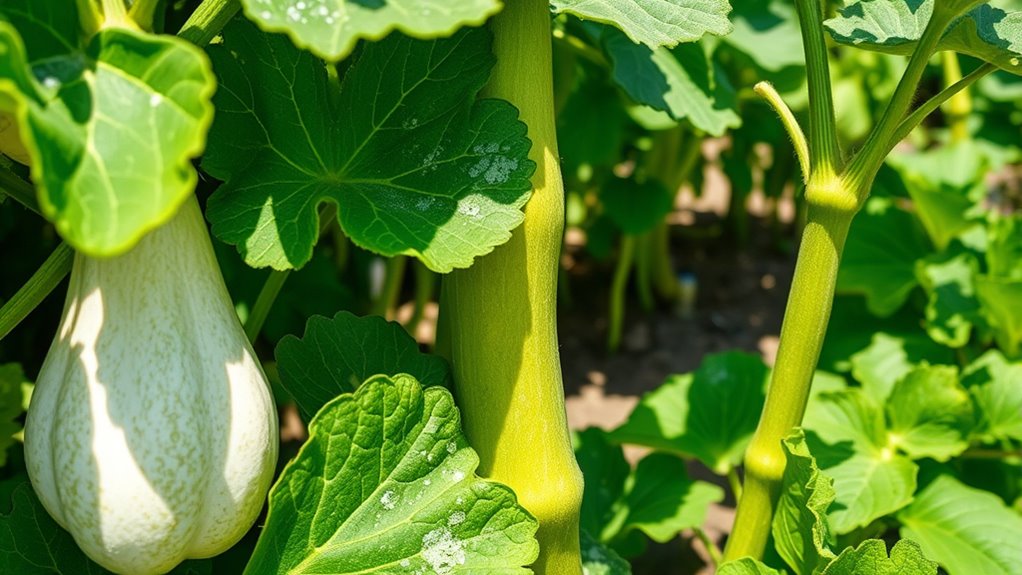
Choosing squash varieties that are resistant to powdery mildew can substantially reduce your risk of infection and minimize the need for chemical treatments. When selecting cultivars, focus on disease resistant varieties known for their resilience against powdery mildew. These resistant cultivars result from careful cultivar selection, which can greatly enhance your garden’s health. Look for labels indicating resistance or tolerance to powdery mildew, and research specific squash types that have demonstrated durability. By prioritizing resistant varieties, you create a strong first line of defense, decreasing the likelihood of infection and reducing your reliance on fungicides. Proper cultivar selection is a proactive step that helps maintain healthy plants, ensuring a more successful and less chemical-dependent squash harvest.
Implementing Preventive Cultural Practices in Your Garden
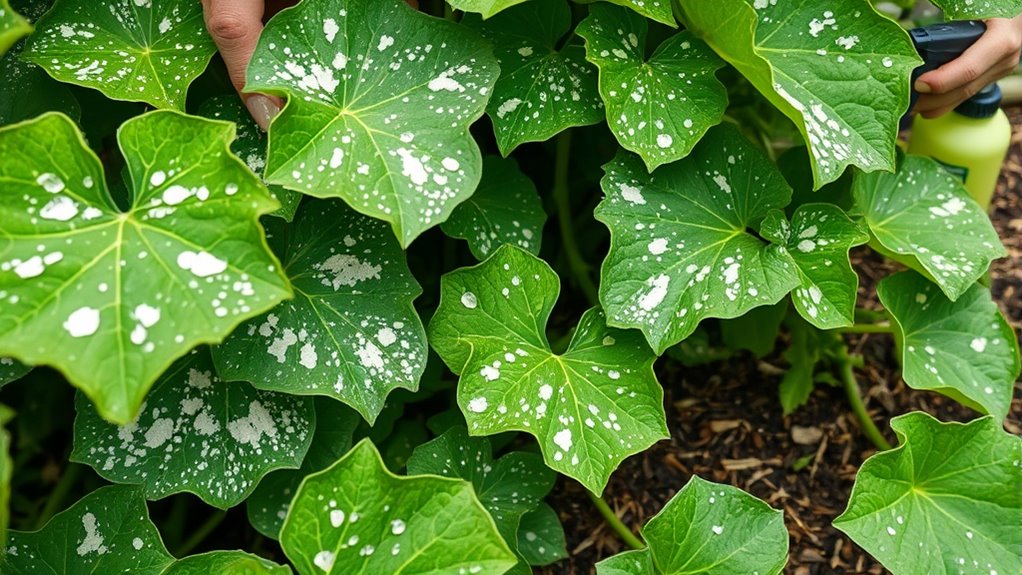
Implementing preventive cultural practices in your garden plays a vital role in reducing the risk of powdery mildew on squash vines. Start by practicing companion planting; plants like nasturtiums or marigolds can deter fungal growth and improve air circulation around your squash. Regular soil testing helps you understand nutrient levels and pH, allowing you to make adjustments that promote healthy, resilient plants less susceptible to disease. Additionally, avoid overcrowding vines, which restricts airflow and creates moist conditions ideal for mildew development. Remove and destroy infected plant debris promptly to prevent spores from spreading. Proper spacing also enhances airflow and reduces humidity around the plants, further decreasing mildew risk. Incorporating GMC tuning techniques to optimize plant health can also contribute to stronger, more resistant vines. Staying vigilant about disease prevention methods ensures early detection and management of potential issues, which can save your plants from severe infections. These practices, combined with proper spacing and soil health, strengthen your squash vines’ defenses, making it harder for powdery mildew to establish and flourish.
Applying Organic and Chemical Treatments Effectively
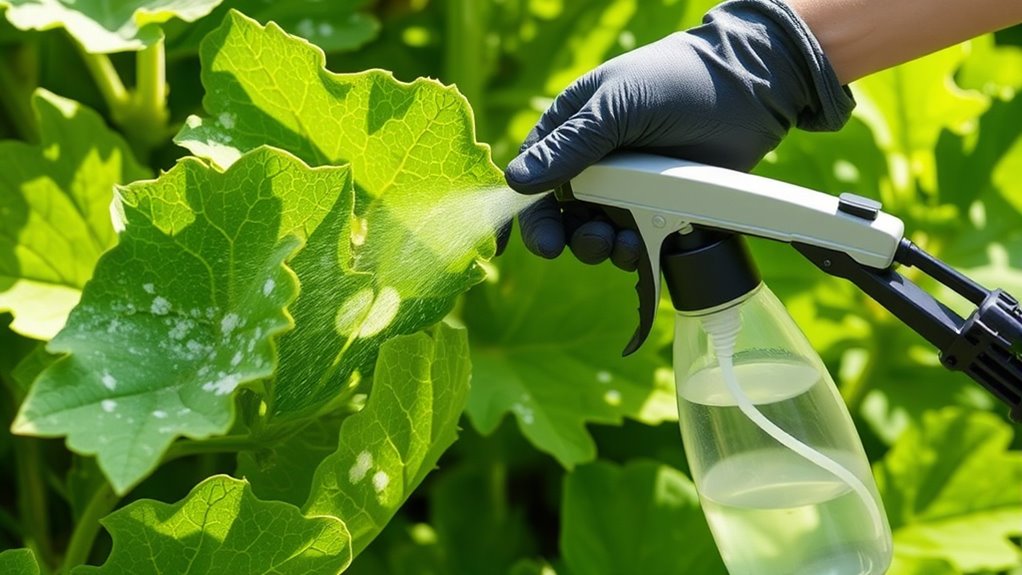
To effectively manage powdery mildew on your squash vines, applying organic and chemical treatments at the right time and in the correct manner is vital. Start by monitoring your plants closely; treat early when symptoms first appear. For organic sprays, use sulfur or neem oil, applying evenly to cover all leaf surfaces. When considering pesticide application, choose products labeled for powdery mildew and follow the manufacturer’s instructions carefully. Timing is key—reapply treatments every 7 to 10 days, especially after rain. Always avoid applying treatments during the hottest part of the day to prevent leaf damage. Proper application ensures better coverage and effectiveness, reducing the spread of the disease and helping your squash vines stay healthy.
Managing Water and Air Circulation to Reduce Moisture
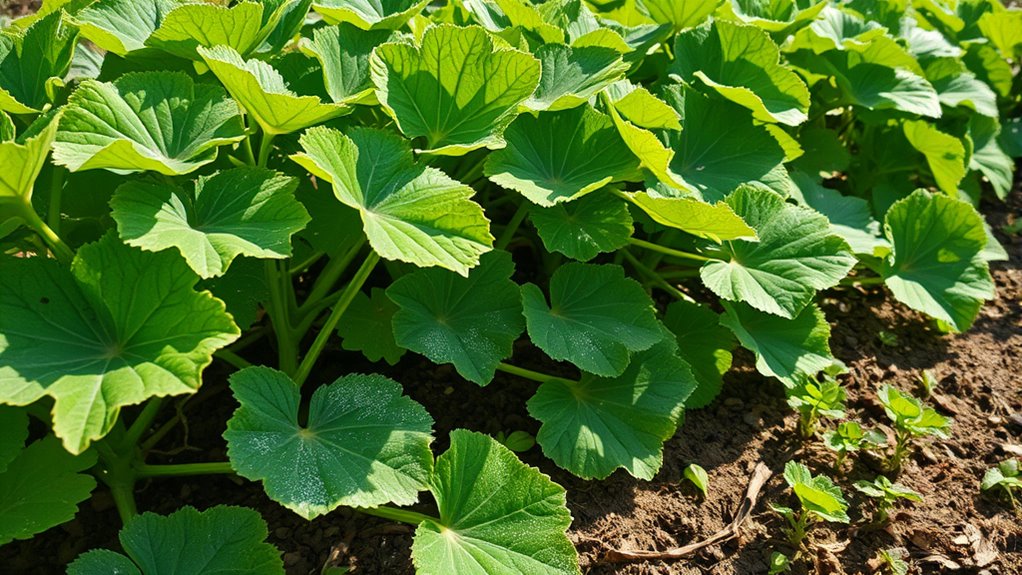
Proper water and air circulation play a vital role in controlling powdery mildew on squash vines. Using appropriate watering techniques, such as watering at the base of the plants early in the day, helps prevent excess moisture on the foliage that fosters mildew growth. Avoid overhead watering, which increases leaf wetness. Mulch application around your squash vines also helps regulate soil moisture, reducing the need for frequent watering and minimizing splashing that can spread spores. Keep the mulch loose and avoid piling it directly against the stems, ensuring good airflow. Additionally, spacing your plants properly improves air movement, helping moisture evaporate quickly and reducing humidity levels around the vines. These practices work together to keep foliage dry and less susceptible to powdery mildew development. Proper storage in a cool, dark place can also extend the effectiveness of fungicides used as a preventive measure. Incorporating aesthetic wall organization solutions in your gardening space can enhance airflow and reduce humidity, further protecting your plants from disease. Moreover, practicing regular pruning removes dense foliage that traps moisture and creates an environment conducive to fungal growth.
Pruning and Removing Infected Plant Material

Regularly pruning your squash vines and removing infected plant material is essential for controlling powdery mildew. Use proper pruning techniques to cut away diseased leaves and stems, making sure to sterilize tools afterward to prevent spreading the fungus. Focus on removing infected debris from the plant and the ground around it, as this helps eliminate sources of spores. When pruning, aim for open, well-ventilated plants that allow better air circulation, which discourages fungal growth. Don’t leave infected debris on the plant or nearby soil, as it can harbor the mildew and lead to future outbreaks. Regular removal of infected material keeps your squash healthy, reduces the spread of powdery mildew, and promotes vigorous growth.
Monitoring and Ongoing Care for Healthy Vines
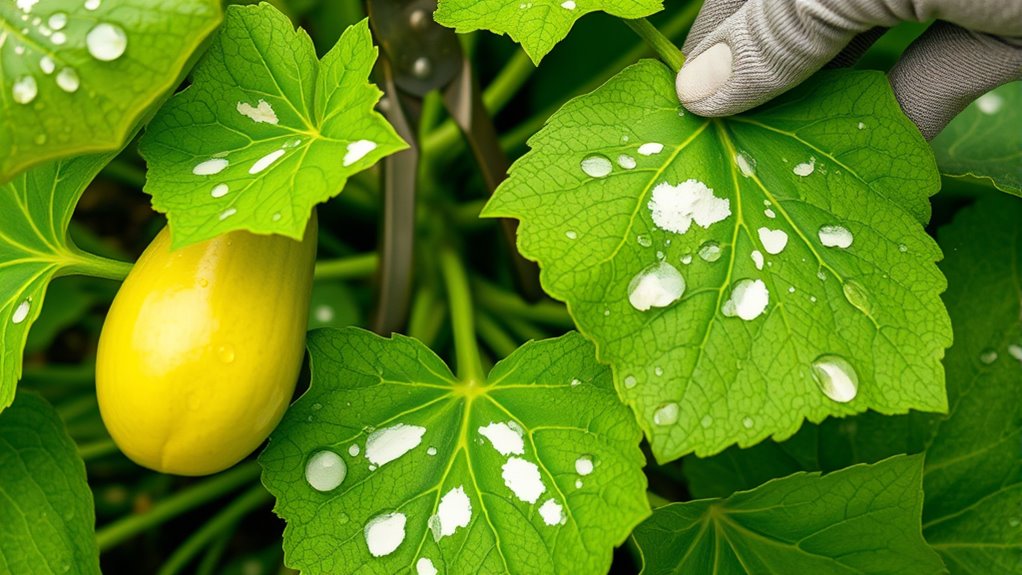
To keep your squash vines healthy, you need to regularly inspect them for signs of trouble. Consistent monitoring helps catch problems early and prevents disease spread. Staying vigilant guarantees your vines stay strong and productive throughout the season.
Regular Vine Inspection
Inspecting your squash vines frequently is essential for catching early signs of powdery mildew and other issues. Regular vine inspection helps you stay ahead of problems, allowing prompt vine maintenance and pest monitoring. By diligently checking your plants, you can spot early symptoms before they spread, saving your crop. This ongoing care not only prevents disease but also boosts overall plant health. When you observe your vines closely, you build a connection that encourages better care and quicker action. Stay vigilant, and don’t overlook the small details that can make a big difference. Remember, consistent inspection is your first line of defense against powdery mildew and other vine ailments.
- Feel the thrill of healthy, thriving vines under your care
- Celebrate each early sign of progress and resilience
- Experience peace of mind knowing you’re actively protecting your crop
- Cultivate pride in your successful garden management
Consistent Disease Prevention
Maintaining vigilant oversight of your squash vines helps prevent powdery mildew from taking hold. Regularly monitor your plants for early signs of disease and address issues promptly. Incorporate soil amendments that boost plant health, such as compost or organic fertilizers, to strengthen resistance. Healthy vines are less vulnerable to infections. Practice pest control to keep insects that can transmit or worsen the disease at bay. Keep the garden tidy by removing infected leaves and debris, which can harbor spores. Consistent care also involves watering at the base to avoid excess moisture on foliage, reducing the risk of mildew. Staying attentive ensures your vines stay vigorous and less susceptible, ultimately minimizing the need for chemical treatments and supporting a healthy, productive garden.
Frequently Asked Questions
Can Companion Planting Help Prevent Powdery Mildew on Squash Vines?
Companion planting can help prevent powdery mildew on squash vines by encouraging beneficial insects that naturally control diseases. You should also practice crop rotation to reduce soil-borne pathogens that contribute to mildew. Planting herbs like basil or nasturtiums nearby attracts helpful insects and improves airflow, which lowers humidity and disease risk. Together, these strategies create a healthier environment, making it harder for powdery mildew to take hold on your squash vines.
Are There Specific Organic Sprays Most Effective Against Powdery Mildew?
You’re wondering if certain organic sprays work best against powdery mildew. Natural remedies like neem oil, potassium bicarbonate, and homemade solutions with baking soda and milk can be effective. Organic formulations often include sulfur or biofungicides that target the fungus without harming your plants. Regular application at the first sign of trouble helps prevent spread, keeping your squash healthy without resorting to chemicals.
How Does Soil Health Influence Susceptibility to Fungal Infections?
Think of your soil as the foundation of a strong fortress; healthy soil with rich nutrients and diverse microbes shields your plants from fungal invaders. When soil lacks nutrients, your squash becomes vulnerable, like a weakened wall. Microbial diversity acts as vigilant guards, fighting off infections before they take hold. By nurturing this balance, you bolster your plants’ defenses, making them more resilient against fungal threats like powdery mildew.
What Timing Is Best for Applying Fungicides During the Growing Season?
When planning your fungicide application schedule, timing strategies are vital. You should apply fungicides early in the growing season, ideally before symptoms appear, to prevent infection. Regularly monitor your plants and use weather forecasts to guide your application schedule. Applying fungicides at the first sign of trouble or during periods of high humidity ensures better protection. Consistent, timely treatments help keep your squash vines healthy and disease-free.
How Can I Differentiate Powdery Mildew From Other Squash Vine Diseases?
Think of disease symptoms as a detective’s clues—powdery mildew shows up as white, powdery spots on leaves, unlike other vine diseases with different signs. To differentiate, look closely at the pattern, color, and texture. Proper pathogen identification is key; powdery mildew’s signature look is a dusty coating. By recognizing these signs early, you can better target your treatment and prevent the disease from spreading further.
Conclusion
By staying vigilant and nurturing your squash vines with thoughtful care, you can gently steer clear of powdery mildew’s quiet influence. Embrace good practices, like proper spacing and timely pruning, to keep your garden thriving. Remember, a healthy vine is like a well-tended conversation—resilient and full of life. With patience and attention, you’ll enjoy a bountiful harvest, letting your garden’s natural harmony shine through without letting pesky fungi cast their shadow.





